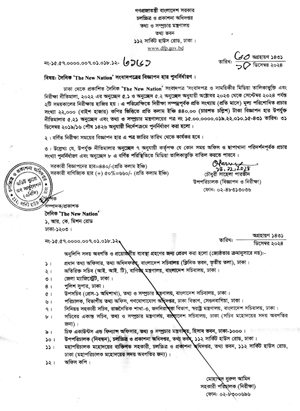Dina Umali-Deininger :
Over the past decade, Bangladesh has made significant improvements in human development indicators, but at the same time, air pollution has surged, presenting a growing challenge to these advancements.
In Bangladesh, the annual average levels of ambient fine particulate matter (PM2.5) range from 60 to 100 µg/m³ across the country and 90 to 100 µg/m³ in Dhaka, way above the World Health Organization’s Air Quality Guideline.
During the dry months from November to March, these can even rise up to two or three times higher than annual averages.
Fine particulate matter (PM2.5), the most harmful pollutant in our air, refers to a group of microscopic substances much smaller than the width of a human hair. Their size allows them to penetrate deep into the lungs and enter the bloodstream, triggering risks of heart disease and lung cancer, among other potentially fatal diseases.
Breathing Dhaka’s air can be equivalent to smoking 1.7 cigarettes per day.
According to the World Bank’s Bangladesh Country Environmental Analysis 2023, the exposure to environmental health risk factors is at critically high levels. Ambient and household air pollution have the most harmful effect on health, leading to more than 159,000 premature deaths annually in the country and more than 2.5 billion days lived with illness.
55 percent of all premature deaths are linked to major environmental health risks. This makes air pollution arguably the biggest environmental risk of our time.
To address these challenges, we must first understand the main sources of these emissions.
While common emitters such as brick kilns and road vehicles are well-known and documented, recent analyses show significant contributions from household activities, power generation, and waste burning—areas that have not received sufficient attention yet.
For instance, around 74.2% of Bangladesh’s population uses solid fuels (e.g. chopped wood, straw, dried dung etc.) as primary cooking fuel , with two-thirds cooking indoors, and at least 53 percent of households rely on traditional cookstoves (BBS 2023).
Additionally, electricity generation from high-sulfur fuel oil-fired power plants have increased substantially, contributing to the deteriorating air quality. In Dhaka, 11 percent of population-weighted annual mean PM2.5 comes from the open burning of municipal solid waste.
These illustrate the multidimensional and multisectoral drivers of air pollution that need to be addressed.
Addressing this crisis requires a collaborative effort from all sectors of society, and involve comprehensive policy reforms aimed at reducing emissions and improving air quality. In this regard, it is great to see the major initiatives adopted by the Government of Bangladesh recently to improve air quality.
Notably, the National Air Quality Management Plan (NAQMP) 2024–2030 approved by the Ministry of Environment, Forest and Climate Change will provide a comprehensive framework to address the country’s severe air pollution challenges by strengthening air quality governance, including updating monitoring and enforcement mechanisms, and reducing emissions from major sources.
Another important milestone is the recently launched real-time air quality index for the country by the Department of Environment (DoE), with support from the National Committee on Air Pollution Control.
The index is based on data from the DoE’s network of 16 Continuous Air Quality Monitoring Stations installed in Dhaka and other country regions, which the NAQMP aims to further expand and strengthen.
Improving air quality requires the meaningful cooperation and alignment of relevant line ministries and agencies, and the continued engagement of an incentivized private sector.
Sectors like power, transport and industry will be essential to achieve the ambitious targets of the NAQMP, with measures planned to promote clean cooking, use of cleaner fuels, cleaner and energy-efficient technologies, enforcement of emission limits, and improved urban mobility.
Only through cleaner and resource efficient production systems can Bangladesh step into the future, not just by complying to meet standards, but in recognition of the long-term benefits of green growth for the economy and the creation of green jobs that support it.
Finally, it is important to understand that air pollution knows no national borders, meaning that solutions from a single country are not sufficient to achieve timely and cost-effective results.
Bangladesh, India, Nepal, and Pakistan share a common airshed that spans the Indo Gangetic Plain, where particulate matter moves across locations. Even if one country did a perfect job cleaning up its domestic emissions, it would still have very polluted air flowing into it from neighboring countries.
Therefore, there is a need for strong regional cooperation through dialogue at various levels to collectively address the problem. The NAQMP emphasizes this commitment from the Government of Bangladesh.
Development partners also have a large role to play, and the World Bank is ready to support the Bangladesh government on this critical agenda.
The time to act is now. We need air to live, and we can all contribute meaningfully to be able to breathe clear air in Bangladesh.
(Dina Umali-Deininger is Regional Director, South Asia Sustainable Development, World Bank Group)




